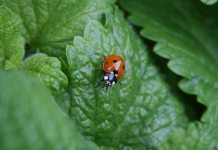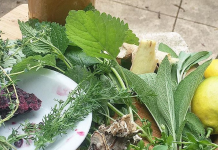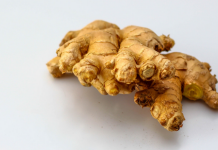
 The Book of Kitchen Witchery: Spells, Recipes, and Rituals for Magical Meals, an Enchanted Garden, and a Happy Home, by Cerridwen Greenleaf
The Book of Kitchen Witchery: Spells, Recipes, and Rituals for Magical Meals, an Enchanted Garden, and a Happy Home, by Cerridwen Greenleaf
Cico Books, 9781782493723, 144 pp., 2016
Spoiler alert: I like this book! It delivers what it promises on the front cover, and does so in a lovely way with wonderful attention to aesthetic and detail that makes it a pleasure to read. It is a paperback, but the quality of the paper is unusually good. It’s also full of beautiful illustrations in a hand drawn watercolour style by artist Emma Garner. The Book of Kitchen Witchery is a nice book that will hold up well in the kitchen, and make great gift.
Author Cerridwen Greenleaf is a poet, medieval scholar, practicing witch, and astrologer. She’s also an educator who leads workshops and has published numerous other volumes on witch- and spellcraft. I was surprised to learn I have another volume of her work, written under her birth name Brenda Knight, Women of the Beat Generation, which won an American Book Award in 1997.
It’s not easy to find a credible book about a Pagan tradition of kitchen witchery. Kitchen witches are intensely devoted to a “do it yourself” ethos, so it’s perhaps unsurprising that volumes of spells, rituals, and teachings aren’t common. Kitchen witchery is also a style of folk magick, and as such its transmission might be more typically oral, from witch to witch or among families, kin, friends, or coven members. It tends to centre on a style of Pagan tradition deeply entrenched in the day to day — this is not witchcraft practiced on esbats, sabbats and full moons only! Kitchen witchery traditionally (and in this book!) is a way to evoke the divine in the day to day, and to make the mundane into ritual. The kitchen witch is one who has an altar in the kitchen, and imbues devotion into everything prepared in the kitchen from tea, to meals, to herbal medicines. The ritual tools are kitchen tools, sacred herbs season the food prepared there, and the mundane work of the kitchen is elevated to something akin to ritual.
Greenleaf has done a wonderful job in creating a volume that a neophyte Wiccan practitioner, or a seasoned kitchen witch might enjoy. It begins with an explanation of creating a kitchen altar, creating a circle, and doing ritual blessings for kitchen work — the preparation of food, or of herbal teas or medicines for yourself or loved ones. She reviews the necessary elements of an altar, ending with a discussion of incense that incorporates a recipe for a circle and a clearing incense. The following chapters cover magical recipes, witches’ brews covering teas, tinctures, infused vinegar and even a liqueur recipe; and the kitchen as pharmacy — healing from the spice rack to nutritional cures. These sections are not exhaustive of course, each one introduces a vast field for potential study, but Greenleaf provides the basic information and many recipes. The recipes are typical comfort foods: soups, stews, a vegetarian roast and a “witch’s cottage pie” that looks wonderful, and is easily adaptable for vegans or omnivores.
Chapter Six discusses the witch’s garden, incorporating plants, herbs and vegetables that have therapeutic and magical properties. This section is useful even for city witches for whom a garden is only a dream, as it points readers towards helpful herbs that can be purchased, if not grown yourself. Access to fresh magical ingredients is helpful for any witch. Greenleaf includes spells that can be performed using herbs for love, wisdom, mental clarity, money, and renewal. Chapter Seven is devoted, slightly incongruously, to love spells! I enjoyed this section, as it adds to the overall tone of the book, which is one of home, hearth, coziness, and mindful self care. It makes sense in a way, since love is often the foundation of a happy home.
Greenleaf discusses the pagan wheel of the year in the final chapter. This includes rituals, spells, and appropriate recipes for celebrating the seasons. This information may be more useful to newbie kitchen witches at the start of the volume, but it’s likely that many readers are already familiar with the wheel of the year and associated celebrations and mythology. This isn’t the type of book that a reader is likely to read through from beginning to end, rather to dip into according to need or interest.
The material covered is very broad in scope. Greenleaf incorporates complex concepts with a light hand, for instance, planets, herbs, and candle magick are discussed in sidebars that provide a brief introduction to the ideas. Of course, it’s not enough information, but a curious practitioner is skillfully directed to ideas that require more in-depth discussion. My only wish here would have been a little bibliography. Like most practicing Pagans, I love seeing book recommendations made by an author I enjoy. These short sidebars would be a wonderful place to direct readers to other noteworthy resources in print or online.
The Book of Kitchen Witchery is a nice addition to any witch’s Pagan library, and is full of great information presented in a straightforward way.








